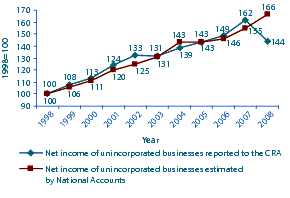Section I: Agency Overview
Message from the Minister
The Canada Revenue Agency (CRA) administers a fair, and responsive tax and benefit system that contributes to the economic and social well being of our nation. The support the CRA provided during the difficult economic climate that dominated 2009-2010 was especially important. By being flexible in how it delivered key aspects of Canada’s Economic Action Plan, the CRA helped secure stability and future prosperity for Canadians.
The CRA is committed to protecting Canada’s revenue base by making sure everyone complies with tax laws. To do this, during 2009-2010, the CRA actively pursued individuals and businesses, including participants in the underground economy and those avoiding taxes by hiding funds offshore, who were not paying the taxes that they owed to Canadians. This document highlights many of the CRA’s achievements over the last year and describes the CRA’s role in supporting individuals, businesses, and families across Canada.
As Minister of National Revenue, I am pleased to present the Departmental Performance Report 2009-2010 for tabling.
The Honourable Keith Ashfield, P.C., M.P.
Minister of National Revenue and
Minister of the Atlantic Canada Opportunities Agency and
Minister for the Atlantic Gateway
Message from the Commissioner and Chief Executive Officer
As Commissioner and Chief Executive Officer, I am accountable to the Minister of National Revenue for all program matters, and to our Board of Management for administrative matters. I am proud to report that the Canada Revenue Agency (CRA) has once again demonstrated its capacity to achieve meaningful and measurable results for Canadians. While we recognize that we have more to do in some areas, our achievements during this past year provide further evidence of the strength of our core business expertise: administering taxes, collecting revenues, and delivering benefits.
The CRA touches the lives of more Canadians than any other single department or agency in the country. In 2009-2010, we processed about $358 billion in taxes and duties and delivered over $17 billion in benefits and credits to millions of individuals and businesses on behalf of Canada’s provinces, territories, other federal departments, and First Nations.
Our 2009-2010 results
During 2009-2010, the CRA placed significant emphasis on ensuring the integrity of Canada’s tax and benefits system. We encouraged compliance with tax legislation by designing initiatives that make it harder for individuals and business to not comply. For example, over the past year we successfully targeted areas like aggressive tax planning and tax havens through partnerships with provinces and international tax administrations, and further refined our risk assessment and management tools. Overall, individuals, corporations, business that collect GST/HST, and employers continued to demonstrate strong levels of voluntary compliance with their registration, filing, and remittance obligations. Our robust system of checks and balances, coupled with the legislative and other compliance tools available to us, provide assurance that Canada’s revenue base is being protected.
We continued to strengthen service as a means of increasing levels of voluntary compliance. In 2009-2010, we took further steps to make it easier for Canadians to comply with legislation by improving access to tax and benefit information and interactive tools.
In our day-to-day activities, we met most of our performance targets for 2009-2010. For those that we did not meet, we sought to understand the factors involved—such as the recent economic downturn—to identify the steps we can take to improve performance in the future.
One particular challenge that we face, which is shared by tax administrations worldwide, is the measurement of the impact of our activities to detect and address non-compliance. Although we continue to achieve strong ratings overall for our performance management framework, we recognize the need to further refine this area.
Moving forward
November 2009 marked the end of our first decade as an agency. The programs and services that we provided over the last 10 years made an important difference in the lives of Canadians. We took on new business, developed and adapted how we worked, built on our management initiatives, and ensured that we continued to deliver on the expectations and needs of taxpayers, businesses, and our government clients. None of this would have been possible without the dedication and hard work of our skilled employees. Their collective knowledge will continue to help us provide innovative and efficient services to individuals and businesses on behalf of the Government of Canada, other levels of government, and First Nations communities.
Our reputation as a world-class tax administration is well-earned and we are proud of our accomplishments over the past year. In submitting this report, I would like to extend my sincere thanks to all of my coworkers, managers, and union leaders who have made the CRA’s successes possible. As we move forward, I remain confident in the dedication, knowledge, and professionalism of our employees as they deliver quality results that matter to Canadians.
Linda Lizotte-MacPherson
Commissioner and Chief Executive Officer
Canada Revenue Agency
Our Raison d’Être
Canada’s tax system is based on voluntary compliance and self-assessment. A well-functioning tax system is critical to the ability of federal, provincial, territorial, and First Nation governments to deliver programs and services that are important to Canadians and Canadian businesses.
The Canada Revenue Agency (CRA) has the mandate to administer tax, benefit, and other programs on behalf of the Government of Canada and provincial, territorial, and First Nations governments.
Parliament created the CRA so we could meet the mandate by:
- providing better service to Canadians;
- offering more efficient and more effective delivery of government programs; and
- fostering closer relationships with provinces and other levels of government for which the CRA delivers programs, and providing better accountability.
The CRA’s mandate reflects the broad role that the CRA plays in the lives of Canadians. The CRA contributes to three of the Government of Canada’s outcome areas:
- A transparent, accountable and responsive federal government;
- Well-managed and efficient government operations; and
- Income security and employment for Canadians.
In 2009-2010 we processed about $358 billion in taxes and duties ($8 billion less than in 2008-2009) on behalf of Canada, the provinces (except Quebec) and territories, and First Nations.We also delivered over $17 billion in benefits and credits, and provided other services that contributed directly to the economic and social well-being of Canadians.
Benefit to Canadians
No other public organization touches the lives of more Canadians on a daily basis than the CRA does. Each year we administer billions of dollars in tax revenue and distribute timely and accurate benefit payments to millions of Canadians. We deliver income-based benefits, credits, and other services that assist families and children, low- and moderate-income households, and persons with disabilities–programs that contribute directly to the economic and social well-being of Canadians.
Our ability to deliver efficient, timely, and accurate high-volume programs and services makes us a valuable partner for government clients.
The following two strategic outcomes summarize the CRA’s contribution to Canadian society.
- Taxpayers meet their obligations and Canada’s revenue base is protected; and
- Eligible families and individuals receive timely and correct benefit payments.
In addition to administering tax and benefit programs, we administered harmonized sales tax for three provinces and verified taxpayer income levels in support of a wide variety of federal, provincial, and territorial programs, ranging from student loans to health care initiatives. We also provided other services, such as our Refund Set-Off Program, through which we helped other federal departments and agencies, as well as provincial and territorial governments, collect debts that might otherwise become uncollectable.
This Performance Report assesses the extent to which we achieved these outcomes during the 2009-2010 fiscal year. On balance, our results show that we met both our strategic outcomes.
Risk Analysis
Our Enterprise Risk Management Program was created to ensure that we develop and implement a systematic and comprehensive approach to managing risks that is fully integrated into our strategic, operational, and financial decision-making processes and mechanisms.
To keep abreast of the risks the CRA faces as an organization, during the planning period, we completed our Corporate Risk Inventory 2009, an integral part our annual strategic planning exercise. The five key priorities of the Corporate Business Plan 2010-2011 to 2012-2013 were based on the highest CRA risks identified in the 2009 inventory (related to payment compliance and the underground economy). A CRA risk action plan was also developed to ensure that we have appropriate response strategies for all the risks identified in the inventory. In this way, the 2009 risk inventory guided the strategic and operational business priorities for the 2010-2011 planning period and led us to integrate risk management in our day-to-day business.
An update to the Corporate Risk Inventory 2009 was also initiated in early 2010. The update indicated that the overall risk profile of the CRA remains generally unchanged from 2009.
We believe that our approach to risk management will help us maintain services to the Canadian public and protect their interests.
Rating our Results
We use qualitative and quantitative indicators, also called measures, to determine the results achieved in terms of our strategic outcomes and expected results. We gather operational data, statistical samples, and survey results that form the basis for our assessments. We continue to face challenges in strengthening our indicators; in particular, ones that are concrete and allow us to make clear links between our achievements and our strategic outcomes and expected results. To this end, we share information with other tax administrations on results measurement through various international forums. In addition, the CRA participates in international initiatives to benchmark key aspects of tax administration with jurisdictions from around the world.
We also rate our strategic results and those of our program activities in terms of whether the targets identified in our Corporate Business Plan 2009-2010 to 2011-2012 were met, mostly met, or not met.
Our targets identify the percentage or degree we expect to attain for a performance level. Where targets are numeric, they are listed beside each indicator. Our management teams establish performance targets by analyzing affordability constraints, historical performance, the complexity of the work involved, and the expectations of Canadians.
Our Program Activity Architecture
The Program Activity Architecture depicted below identifies our program activities and demonstrates how they link to our strategic outcomes. Program activities are groups of related activities that are designed and managed to meet a specific public need and reflect how we allocate and manage our resources to achieve intended results.
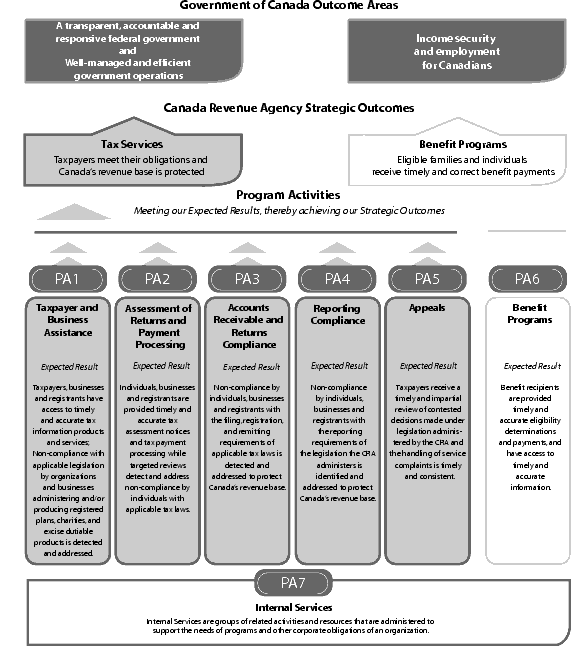
Performance Summary
|
2008-2009 Actual[Footnote 1]
|
||||||
|---|---|---|---|---|---|---|
|
Taxpayer and Business Assistance[Footnote 2]
|
||||||
|
Assessment of Returns and Payment Processing[Footnote 3]
|
||||||
|
Accounts Receivable and Returns Compliance[Footnote 4]
|
||||||
|
Benefit Programs[Footnote 5]
|
||||||
|
Internal Services1
|
||||||
|
Taxpayers’ Ombudsman1
|
||||||
2009-2010 Financial Resources (in thousands of dollars)
2009-2010 Human Resources
Contribution of Priorities to Strategic Outcomes
As identified in our 2009-2010 Report on Plans and Priorities, our tax and benefit focus over the planning period was on tax integrity, strengthening service, benefits validation, effective relationships, and business sustainability.
The following table identifies the strategic priorities we pursued in 2009-2010, our results, and how these priorities support our Strategic Outcomes. Additional details concerning individual program activity achievements related to these strategic priorities are provided in Section II: Analysis of Program Activities by Strategic Outcome.
Our Strategic Outcome Measures
We use our strategic outcome measures to gauge the compliance behaviour of Canadian taxpayers. Using data from internal and external sources as a baseline of compliance information, we group our indicators into the following four broad categories of taxpayer obligations to help us measure and assess our results against our Tax Services strategic outcome. These four categories are: registration compliance, filing compliance, remittance compliance, and reporting compliance.
To facilitate further research and discussion of compliance, we analyze the following segments of the population: individuals, self-employed individuals, corporations, GST/HST registrants, and employers. Our discussion of compliance includes macro-indicators which help us evaluate reporting compliance trends and to determine if the economic data provides an early indication of a change in the levels of compliance
Registration compliance
Registration Compliance estimates the proportion of Canadian businesses that have registered as required by law to collect the GST/ HST.
|
Our Indicator[Footnote 1]
|
|||||||
|---|---|---|---|---|---|---|---|
Our estimates of the rate of registration compliance have remained consistently above our target over the past several years.
Our assessment is also supported by the results from our non-registrant program which seeks to ensure that all businesses that are required to register for the GST/HST meet their obligations. Each year, this program identifies several thousand small businesses that are required to register, mostly those that are new or that recently exceeded the registration threshold. We are persuaded, therefore, that there is a very low risk that medium-sized or large enterprises are carrying on business without being registered to collect the GST/HST.
Filing compliance
Filing Compliance indicators estimate the proportion of the Canadian population who file their returns on time.
|
Corporations – taxable incorporated businesses that filed their returns on time[Footnote 1]
|
|||||||
To gauge the compliance of individual taxpayers with their obligation to file a timely return, we compare our data for individual filers 18 years of age and older with Statistics Canada’s Census of Population data for this population. In fact, these estimates have consistently remained above the 92.5% level for every year since the 2001-2002 reporting year, providing a reliable trend for the high degree of voluntary filing compliance that we observe.
Our research on filing behaviour shows that, of the remaining individuals who were not compliant (7.2% in both 2005-2006 and 2009-2010), a large majority file their return within five years. For instance, although 92.6% of individuals filed their returns on time for the 2003 tax year, this percentage rose to 97.4% in less than five years. Filing for the following tax year (2004) showed exactly the same pattern, reaching 97.4% in less than five years, and filing behaviour for subsequent years follows a similar trajectory. We have learned from this research that the majority of non-compliant individual filers comply within about five years, indicating a long-term non-filing rate of about 2.6% for the 18-year-and-older population. Over the last six tax years, more than two thirds of the returns filed late owed no taxes for any tax year at the time of filing, with the remaining third owing taxes for at least one tax year.
Remittance compliance
Remittance compliance indicators estimate the proportion of taxpayers who owed taxes and paid the full amount on time.
|
Trend in ratio of outstanding tax debt to gross cash receipts[Footnote 1]
|
We measure how various taxpayer segments comply with their remittance requirements by the degree to which they paid all taxes, based on their self-assessment, on or before the due date. When monies owed are not paid at the time of filing, we take steps to obtain payment.
For employers who remit at-source deductions on behalf of their employees, the rate of timely remittance has been below our target of 90% for several years. This year, however, our estimate indicates, that employers have remitted in a more timely fashion compared to previous years. On this basis, we are inclined to conclude that we mostly met our target for this compliance measure.
Reporting compliance
We conduct various reviews and audits to identify areas where reporting by individuals and corporations may not be consistent with their obligations to report complete and accurate information.
In 2009-2010, our review programs estimated that 15.4% of claims or deductions made by individuals were non-compliant, meaning they would be disallowed following a review[Footnote 1] . It should be noted that the number and type of credits and deductions have changed over the 2007-2008 to 2009-2010 period, so that the non-compliance rate shown in the above table represents both changes in compliance and in the scope of the study.
For large businesses, we detect and address non-compliance through a combination of corporate audits and risk assessment, which includes research and monitoring. The process involves an annual risk assessment of large taxpayers that uses expertise from across CRA to assess the risk levels using information related to the nature of the taxpayer’s business, their current and past behaviour including aggressive tax planning, transparency, as well as information available from our tax treaty partners that indicate potential risk of non compliant behaviour. We have increased our use of research relating to risk based targeting of large business in response to the evolution of large businesses as a result of globalization and electronic commerce that have made certain complex business structures more prone to risks of non-compliance.
For small businesses, including self-employed individuals, we rely more on risk assessment in selecting businesses for audit. Our Small and Medium-sized Enterprise (SME) audit program selects its audits based on a range of risk information that includes past risk history and business condition indicators that are associated with non-compliance risk.
We also monitor and analyze a number of macro indicators that gauge trends in taxpayer behaviour with respect to reporting compliance.
Macro indicators
Figure 1 The trend in personal income reported to the CRA compared to personal income estimated by Statistics Canada
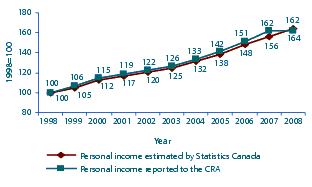
Figures for the years 2005, 2006, and 2007 have been restated as a result of improved data.
Figure 2 The trend in corporate income taxes that we have assessed compared to corporate profits before tax reported to Statistics Canada
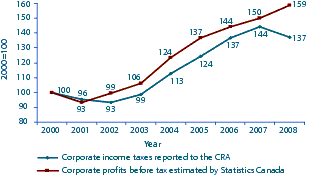
Figures for the years 2001 and 2002 have been restated as a result of improved data.
Figure 3 The trend in net income of unincorporated businesses reported to us compared to Statistics Canada’s estimate for its National Accounts
Figures for the years 2005, 2006, and 2007 have been restated as a result of improved data
Figure 4 The trend in CRA’s net GST/HST revenue compared with retail sales and personal expenditure estimated by Statistics Canada
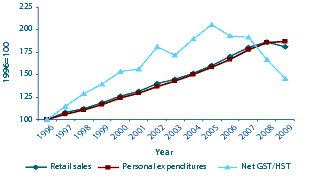
Conclusion
Our strategic outcome measures provide estimates of filing, registration, remittance, and reporting compliance to gauge the levels of voluntary compliance with Canada’s tax laws. Our review of these estimates for 2009-2010 indicates that voluntary compliance remained generally high, although the dollar value of identified non-compliance is financially significant. Our assessment of our results indicators is that they are consistent with a high level of taxpayer compliance.
It is our assessment that we met our Tax Services strategic outcome in 2009-2010. We draw our overall conclusion largely from the significant proportion of Canada’s revenue base originating from personal income that is subject to third-party reporting, and that a major proportion of the remainder originates from large corporations that are subject to a high rate of audit coverage. In addition, much of our assurance that we are achieving our strategic outcome is based on our robust system of checks and balances, which includes both preventive and detective activities. These activities incorporate a mix of compliance tools to protect Canada’s revenue base from non-compliance.
Our Benefit Programs Strategic Outcome Measures
|
Not Applicable[Footnote 1]
|
|||||||
It is our assessment that we met our Benefit Programs strategic outcome. Through our efforts in administering benefit programs, eligible families and individuals received timely and correct benefit payments, and our government clients were afforded reliable services, enjoyed lower administration costs and more effective compliance. Benefit recipients can rely on the CRA to administer a better-integrated benefits system of high integrity and be assured that the CRA contributes to reducing the overall cost of government in Canada.
For more discussion on our performance against our Strategic Outcomes, please visit:
www.cra.gc.ca/annualreport
Expenditure Profile
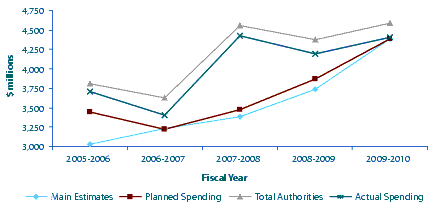
For the 2005-2006 to 2009-2010 period, total spending includes all Parliamentary appropriations and revenue sources: Main Estimates, Supplementary Estimates, Treasury Board Vote 5 – Government Contingencies, Vote 15 – Compensation Adjustments and Vote 23 – Paylist Requirements as well as carry forward adjustments. It also includes spending of revenues received through the conduct of the Canada Revenue Agency’s (CRA) operations pursuant to Section 60 of the Canada Revenue Agency Act, Children’s Special Allowance payments, payments to private collection agencies pursuant to Section 17.1 of the Financial Administration Act and statutory disbursements to the provinces under the Softwood Lumber Products Export Charge Act, 2006.
Since 2005-2006, the Canada Revenue Agency’s Vote 1 reference levels have increased primarily as a result of: collective agreements/contract awards; legislative, enhanced audit and enforcement measures, including policy and operational initiatives arising from various Federal Budgets and Economic Statements; the transfer from the Department of Public Works and Government Services Canada for accommodations and real property services; and the assumption of the responsibilities related to the Corporate Tax Administration for Ontario, the Softwood Lumber Agreement and Inter-Provincial Compliance.
The increases to Vote 1 have been offset by a number of reduction exercises including: the 2005 Expenditure Review and Procurement reductions, the 2006 Expenditure Restraint Program, the 2007 Federal Budget Cost Efficiency Savings and the 2008 Federal Budget Strategic Review reductions
The Agency’s Statutory Authorities have fluctuated over the course of the 2005-2006 to 2009-2010 period as a result of: adjustments to the Children’s Special Allowance payments for eligible children in the care of specialized institutions; adjustments to the rates for the contributions to employee benefit plans; increases to the spending of revenues received through the conduct of operations pursuant to Section 60 of the Canada Revenue Agency Act; the introduction from 2007-2008 to 2009-2010 of payments to private collection agencies pursuant to Section 17.1 of the Financial Administration Act; and the statutory disbursements to the provinces under the Softwood Lumber Products Export Charge Act, 2006.
In 2009-2010, of the $4,586.2 million total authority, CRA’s actual spending totalled $4,406.5 million resulting in $179.6 million remaining unexpended at year-end. After deducting unused resources related to the proposed Offshore Trusts initiative, Accommodation and Real Property Services, and costs for the Employee Benefits Plan associated with the conversion of Other Operating to Personnel costs, the remaining $150.3 million is available for use by the Agency in 2010-2011. This amount represents 3.3% of the total authority.
Voted and Statutory Items
Authorities approved after tabled Main Estimates
The following table details the authorities approved for the Agency after the Main Estimates and reconciles with the Total Authorities shown on  .
.
[Footnote 1] Credits and deductions for the random sample in 2009-2010 included an additional credit compared to the previous year with a rate of non-compliance lower than the average. Excluding this item would result in a non-compliance rate of 17%. Similarly, the study that produced the 2008-2009 results included an item that was not part of the key credits and deductions of the prior year. Excluding the latter from both 2008-2009 and 2009-2010 would result in non-compliance rates of 16.2% and 16.7%.
- Date modified:


